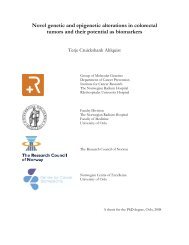Preface - Ous-research.no
Preface - Ous-research.no
Preface - Ous-research.no
Create successful ePaper yourself
Turn your PDF publications into a flip-book with our unique Google optimized e-Paper software.
Molecular Cardiology<br />
sion of heart failure Does CCN2 cause myocardial fibrosis<br />
In order to elucidate to the physiologic actions of CCN2<br />
in the heart and to investigate how the actions of CCN2<br />
may contribute in the pathophysiology of heart failure,<br />
we are currently investigating various transgenic models<br />
with constitutive or conditional overexpression of CCN2<br />
in the heart generated in our laboratory. The transgenic<br />
mice with cardiac-restricted, constitutive overexpression<br />
of CCN2/CTGF displayed marginal increase of myocardial<br />
collagen contents despite 70-fold overexpression of CCN2/<br />
CTGF (Ahmed, MS et al. Am J Physiol Heart Circ Physiol; Dec<br />
24, 2010 [epub ahead of print]). This finding appears to be<br />
consistent with overexpressors of CCN2/CTGF in other tissues<br />
or organs. Thus, the interpretation of the available data<br />
both from our and other <strong>research</strong> groups is that additional<br />
factors are required for CCN2 to induce fibrosis. A surprising,<br />
<strong>no</strong>vel finding in our laboratory was that CCN2 exerts striking<br />
cardioprotective actions, increasing tolerance towards<br />
ischemia-reperfusion injury both in Langendorff-perfused<br />
hearts ex vivo and in mice subjected to transient ligation of<br />
the left anterior descending coronary artery in situ. These<br />
findings have led to filing of patents for protection of the<br />
potential commercial development of CCN2/CTGF as a pharmacologic<br />
treatment in acute coronary syndromes with the<br />
objective of minimizing myocardial necrosis. Verification of<br />
the data in large animal models, commercial development<br />
plans, including plans for early clinical testing, are currently<br />
being pursued in collaboration with Birkeland In<strong>no</strong>vation/<br />
Inven2 AS, the TTO of University of Oslo and Oslo University<br />
Hospital.<br />
A cognate receptor for CCN2 or any of the other CCN proteins<br />
has <strong>no</strong>t yet been characterized. Despite several reported<br />
interactions between CCN proteins and extracellular matrixassociated<br />
protein, data from our laboratory indicate that<br />
CCN2 also acts directly on cells by binding to ligands at the<br />
surface of the plasma membrane. Furthermore, analysis of<br />
the phosphoproteome of cardiac myocytes stimulated in<br />
the absence of presence of recombinant CCN2 revealed that<br />
the PI3 kinase/AKT/GSK-3ß pathway is major intracellular<br />
signaling pathway of CCN2 (Fig. 1). Indeed, our data also demonstrate<br />
that this pathway is crucial for CCN2-dependent<br />
cytoprotection towards hypoxia. The mechanisms of the cytoprotective<br />
actions of CCN2 are currently a major endeavor<br />
in our <strong>research</strong> group.<br />
Figure 1. Schematic illustrating the intracellular signaling pathways<br />
of CTGF/CCN2 in cardiac myocytes. A cognate receptor for<br />
CTGF upstream of PI3 kinase has <strong>no</strong>t yet been characterized.<br />
Collaborators<br />
Prof. Robert J. Lefkowitz, Dept. of Medicine, Duke University<br />
Medical Center, Durham, USA.<br />
Prof. Neil Freedman, Dept. of Cardiology, Duke University<br />
Medical Center, Durham, NC 27710, USA<br />
Prof. Walter J. Koch, Center for Translational Medicine, Jefferson<br />
Medical College, Philadelphia, PA, USA.<br />
Prof. Roel Goldschmeding, Dept. of Pathology, Utrecht University<br />
Medical Center, The Netherlands.<br />
Prof. Otto A. Smiseth, Dept. of Cardiology/Inst. for Surgical<br />
Research, Oslo University Hospital.<br />
Prof. Thor Edvardsen, Dept. of Cardiology/Inst. for Surgical<br />
Research, Oslo University Hospital.<br />
Prof. Guro Valen, Inst. of Basic Medical Sciences, Dept. of<br />
Physiology, University of Oslo.<br />
Prof. Geir Christensen, Oslo University Hospital.<br />
Prof. Jan-Bjørn Osnes, Dept. of Pharmacology, University of<br />
Oslo.<br />
Prof. Tor Skomedal, Dept. of Pharmacology, University of<br />
Oslo.<br />
Prof. Finn Olav Levy, Dept. of Pharmacology, University of<br />
Oslo.<br />
Prof. Terje S. Larsen, Dept. of Medical Physiology, University<br />
of Tromsø, Norway.<br />
Assoc. prof. Ellen Aasum, Dept. of Medical Physiology, University<br />
of Tromsø, Norway.<br />
Prof. Pål Aukrust, MD, PhD, Research Inst. for Internal Medicine,<br />
Oslo University Hospital.<br />
Dr. Leif Erik Vinge, M.D., Ph.D., Dept. of Cardiology/ Research<br />
Inst. for Internal Medicine, Oslo University Hospital.<br />
17
















